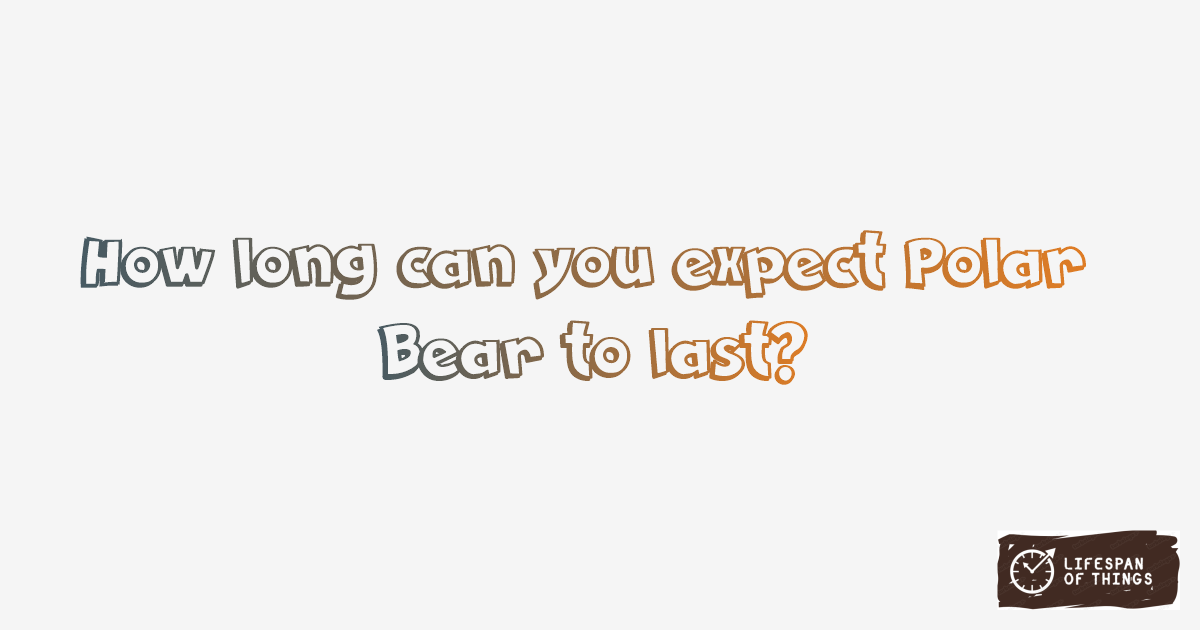
15 - 25 Years
Lifespan of Polar Bear is 15 - 25 Years. Polar Bears live in the Arctic region and are adapted to cold climates. Their lifespan is influenced by factors like food availability, climate change, and human activities. Conservation efforts play a crucial role in preserving their habitat and sustaining their population.
Useful Information
Polar Bears inhabit the Arctic region, including sea ice, coastlines, and islands. They rely on sea ice for hunting seals and breeding. Climate change poses a threat to their habitat, affecting their ability to find food and mate.
Polar Bears primarily feed on seals, especially ringed and bearded seals. Their diet consists mainly of fatty meats to sustain their energy needs in the cold environment. Seal hunting on sea ice is essential for their survival.
Predators rely on a meat-based diet rich in protein and fats to fuel their energy needs and maintain their strength for hunting.
To improve the lifespan of Polar Bears, conservation efforts focus on reducing human impact, such as pollution and hunting. Providing protected areas and regulating industrial activities help preserve their habitat. Monitoring health through research and satellite tracking aids in understanding their behaviors and needs.
Polar Bears exhibit solitary behavior, except during mating or family interactions. Training them is not feasible in the wild. Understanding their body language and respecting their space is key to observing them safely. Avoiding human interactions ensures their natural behaviors are not disrupted.
Polar Bears are listed as vulnerable due to climate change and hunting. Conservation efforts include regulating hunting quotas, establishing protected areas, and raising awareness about their conservation status. Collaborative research and monitoring programs help track their population trends and implement effective conservation measures.
Lifespan Comparisons
| Compared Item | Comparison Description |
|---|---|
| Lifespan of Gray Wolf | Polar Bears have a similar lifespan to Gray Wolves, both living around 15 years on average. |
| Lifespan of Komodo Dragon | Komodo Dragons can live 30-50 years, outlasting Polar Bears by a significant margin. |
| Lifespan of Hyena | Hyenas have a slightly shorter lifespan compared to Polar Bears, living up to 15 years. |
| Lifespan of Crocodile | Both Crocodiles and Komodo Dragons share a lifespan of 30-50 years, surpassing Polar Bears in longevity. |
| Lifespan of Fish | Fish typically have a shorter lifespan than Polar Bears, lasting around 5-10 years on average. |
| Lifespan of Marine Mammals | Marine Mammals can live up to 40-60 years, significantly longer than Polar Bears. |
| Lifespan of Coral Reef Animals | Coral Reef Animals have a lifespan ranging from 20-50 years, overlapping with the lifespan of Polar Bears. |
| Lifespan of Sharks | Sharks can live 20-50 years, similar to the lifespan of Polar Bears. |
| Lifespan of Karl Storz Video Endoscope | Karl Storz Video Endoscope has a short lifespan of approximately 7-10 days, vastly different from Polar Bears. |
| Lifespan of Fujifilm Endoscopy Tower | Fujifilm Endoscopy Tower boasts a lifespan of 10-15 years, longer than Polar Bears. |
| Lifespan of Stryker Arthroscopy System | Stryker Arthroscopy System can last 10-15 years, similar to the lifespan of Polar Bears. |
| Lifespan of COVID-19 Rapid Test Kit | COVID-19 Rapid Test Kit is designed to be used within 1-2 years, contrasting with the lifespan of Polar Bears. |
| Lifespan of HIV Diagnostic Kit | HIV Diagnostic Kit offers a longer lifespan of 5-10 years compared to Polar Bears. |
| Lifespan of Malaria Test Kit | Malaria Test Kit is expected to be effective for 1 year or more, differing from the lifespan of Polar Bears. |
| Lifespan of Cholesterol Test Kit | Cholesterol Test Kit can be used for 2-5 years, showcasing a different lifespan compared to Polar Bears. |
Frequently Asked Questions
Lifespan of Polar Bear is 15 - 25 Years.
Climate change poses a threat to Polar Bears' habitat by affecting their ability to find food and mates due to melting sea ice.
Polar Bears primarily feed on seals, especially ringed and bearded seals, to sustain their energy needs in the icy environment.
Conservation efforts focus on reducing human impact, establishing protected areas, and monitoring health through research to preserve the habitat and sustain their population.
Polar Bears exhibit solitary behavior except during mating or family interactions, making them fascinating yet mysterious creatures.
Polar Bears are listed as vulnerable due to climate change and hunting, which threaten their population. Conservation efforts are essential to protect their future.








